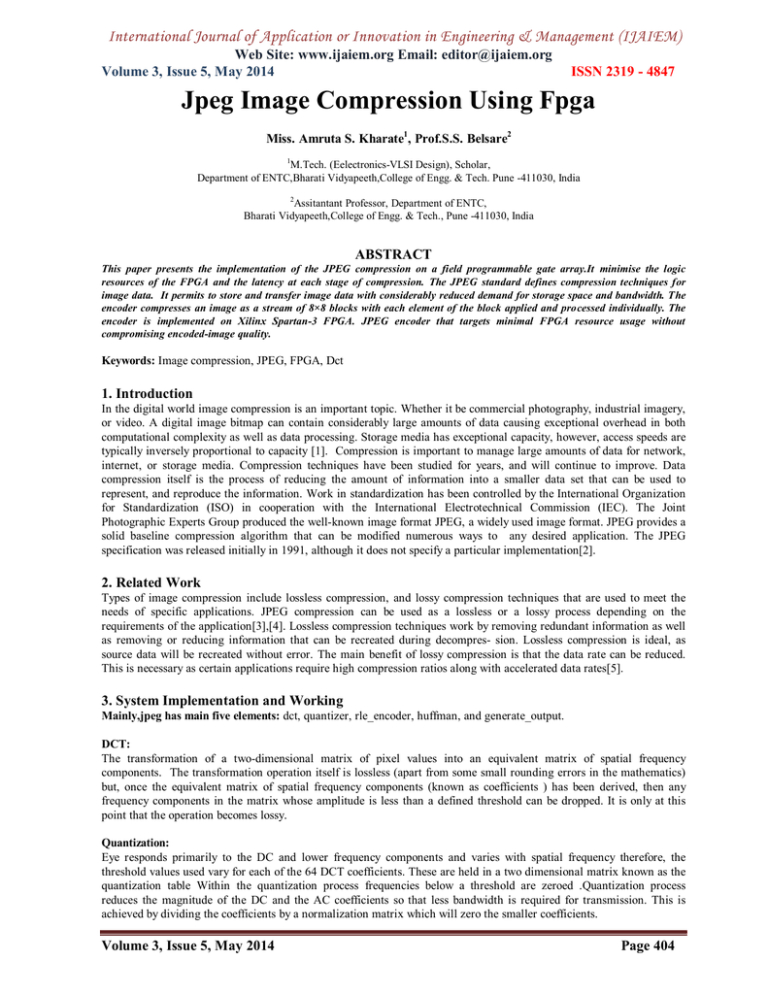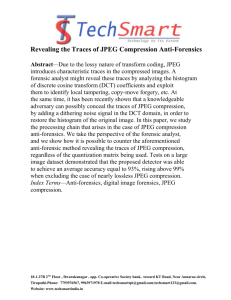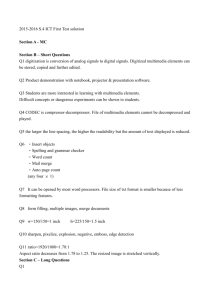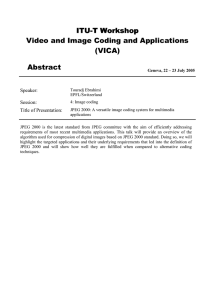Jpeg Image Compression Using Fpga Web Site: www.ijaiem.org Email:
advertisement

International Journal of Application or Innovation in Engineering & Management (IJAIEM) Web Site: www.ijaiem.org Email: editor@ijaiem.org Volume 3, Issue 5, May 2014 ISSN 2319 - 4847 Jpeg Image Compression Using Fpga Miss. Amruta S. Kharate1, Prof.S.S. Belsare2 1 M.Tech. (Eelectronics-VLSI Design), Scholar, Department of ENTC,Bharati Vidyapeeth,College of Engg. & Tech. Pune -411030, India 2 Assitantant Professor, Department of ENTC, Bharati Vidyapeeth,College of Engg. & Tech., Pune -411030, India ABSTRACT This paper presents the implementation of the JPEG compression on a field programmable gate array.It minimise the logic resources of the FPGA and the latency at each stage of compression. The JPEG standard defines compression techniques for image data. It permits to store and transfer image data with considerably reduced demand for storage space and bandwidth. The encoder compresses an image as a stream of 8×8 blocks with each element of the block applied and processed individually. The encoder is implemented on Xilinx Spartan-3 FPGA. JPEG encoder that targets minimal FPGA resource usage without compromising encoded-image quality. Keywords: Image compression, JPEG, FPGA, Dct 1. Introduction In the digital world image compression is an important topic. Whether it be commercial photography, industrial imagery, or video. A digital image bitmap can contain considerably large amounts of data causing exceptional overhead in both computational complexity as well as data processing. Storage media has exceptional capacity, however, access speeds are typically inversely proportional to capacity [1]. Compression is important to manage large amounts of data for network, internet, or storage media. Compression techniques have been studied for years, and will continue to improve. Data compression itself is the process of reducing the amount of information into a smaller data set that can be used to represent, and reproduce the information. Work in standardization has been controlled by the International Organization for Standardization (ISO) in cooperation with the International Electrotechnical Commission (IEC). The Joint Photographic Experts Group produced the well-known image format JPEG, a widely used image format. JPEG provides a solid baseline compression algorithm that can be modified numerous ways to any desired application. The JPEG specification was released initially in 1991, although it does not specify a particular implementation[2]. 2. Related Work Types of image compression include lossless compression, and lossy compression techniques that are used to meet the needs of specific applications. JPEG compression can be used as a lossless or a lossy process depending on the requirements of the application[3],[4]. Lossless compression techniques work by removing redundant information as well as removing or reducing information that can be recreated during decompres- sion. Lossless compression is ideal, as source data will be recreated without error. The main benefit of lossy compression is that the data rate can be reduced. This is necessary as certain applications require high compression ratios along with accelerated data rates[5]. 3. System Implementation and Working Mainly,jpeg has main five elements: dct, quantizer, rle_encoder, huffman, and generate_output. DCT: The transformation of a two-dimensional matrix of pixel values into an equivalent matrix of spatial frequency components. The transformation operation itself is lossless (apart from some small rounding errors in the mathematics) but, once the equivalent matrix of spatial frequency components (known as coefficients ) has been derived, then any frequency components in the matrix whose amplitude is less than a defined threshold can be dropped. It is only at this point that the operation becomes lossy. Quantization: Eye responds primarily to the DC and lower frequency components and varies with spatial frequency therefore, the threshold values used vary for each of the 64 DCT coefficients. These are held in a two dimensional matrix known as the quantization table Within the quantization process frequencies below a threshold are zeroed .Quantization process reduces the magnitude of the DC and the AC coefficients so that less bandwidth is required for transmission. This is achieved by dividing the coefficients by a normalization matrix which will zero the smaller coefficients. Volume 3, Issue 5, May 2014 Page 404 International Journal of Application or Innovation in Engineering & Management (IJAIEM) Web Site: www.ijaiem.org Email: editor@ijaiem.org Volume 3, Issue 5, May 2014 ISSN 2319 - 4847 Rle-encoder and huffman: These units achieve additional compression by encoding the quantized DCT coefficients more compactly based on their statistical characteristics. Here, they are implemented as in typical JPEG encoders. Four Huffman tables are utilized: two for the DC and AC luminance components and two for the DC and AC chrominance components. The quantized DC coefficient is encoded based on its category as the difference from that of the previous block in the encoding order. The quantized AC coefficients are encoded as (run, cat), where run is the number of zeros preceding a non-zero value and cat is the category of this value. Generate output: This unit handles two constraints set by the JPEG standard. The first constraint is that the maximum run is 15. The second is that when there are zeros till the end of the block, a Huffman code corresponding to run=0 and cat=0 has to be sent. These constraints are handled by introducing four delay stages that force the output to be delayed so as to detect any sequence (run, cat) of (15, 0) and (0, 0). The delay stages are determined to be four because for an 8×8 block there may be a maximum of three (15, 0) which may be followed by (0, 0). A data ready signal, dr, is generated for each valid output and a required block signal, rb, is generated when a complete block is encoded to indicate readiness to receive the next image block. 4. Conclusion Implementation of hardware of a JPEG encoder that targets minimal usage of FPGA resources is provided. The provided encoder is well-suited to low-cost FPGAs. The reduction in resource requirements doesn’t come at the expense of encoded image quality. The JPEG encoder was implemented on Xilinx Spartan-3 XC3S200. Its speed performance was suitable for applications as scanners and still cameras. References [1] E. Farzad, C. Matthieu, and W. Stefan, "JPEG versus JPEG 2000: an objective comparison of image encoding quality," SPIE Proceedings, vol. 5558, pp. 300-308, 2004. [2] K. Sakiyama, P. R. Schaumont, and I. M. Verbauwhede, "Finding the best system design flow for a high-speed JPEG encoder," Asia and South Pacific Design Automation Conference (ASP-DAC), pp. 577-578, 2003. [3] A. Staller, P. Dillinger, and R. Manner, Implementation of the JPEG2000 Standard on a Virtex 1000 FPGA. Springer Berlin/Heidelberg Publishers, 2002. [4] T. Acharya and Ping-Sing Tsai, JPEG2000 Standard for Image Compression Concepts, Algorithms and VLSI Architectures. John Wiley & Sons press, 2005. [5] C. Christopoulos, A. Skodras, and T. Ebrahimi, "The JPEG2000 still image coding system: an overview," IEEE Transactions on Consumer Electronics, vol. 46, no. 4, pp. 1103-1127, 2000. [6] GIF89a, "Graphics Interchange Format Specification," Columbus,: OH: CompuServe, Inc. [7] S. Gordoni, "Investigation of Hardware JPEG Encoder Implementation and Verification Methodologies," Department of Electrical and Computer Engineering, University of California Santa Barbara 2006. [8] D. G. Bailey, in Design for Embedded Image Processing on FPGAs: John Wiley & Sons (Asia) Pte Ltd, 2011. [9] S. H. Sun and S. J. Lee, "A JPEG Chip for Image Compression and Decompression," The Journal of VLSI Signal Processing, vol. 35, no. 1, pp. 43-60, 2003. [10] M. Kovac and N. Ranganathan, "JAGUAR: a fully pipelined VLSI architecture for JPEG image compression standard," Proceedings of the IEEE, vol. 83, no. 2, pp. 247-258, 1995. [11] Kyeong-Yuk Min and Jong-Wha Chong, "A design of real-time JPEG encoder for 1.4 mega pixel CMOS image sensor SoC," IEICE-Tran Fund Elec, Comm, & Comp Sci, vol. E88-A, no. 6, pp. 1443-1447, 2005. [12] A. Tumeo, M. Monchiero, G. Palemo, F. Ferrandi, and D. Sciuto, "An internal partial dynamic reconfiguration implementation of the JPEG encoder for low-cost FPGAs," IEEE Computer Society Annual Symposium on VLSI (ISVLSI), pp. 449-450, 2007. Volume 3, Issue 5, May 2014 Page 405




